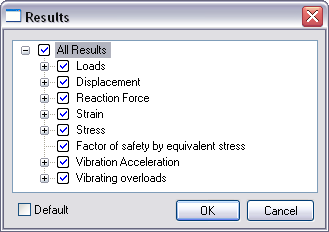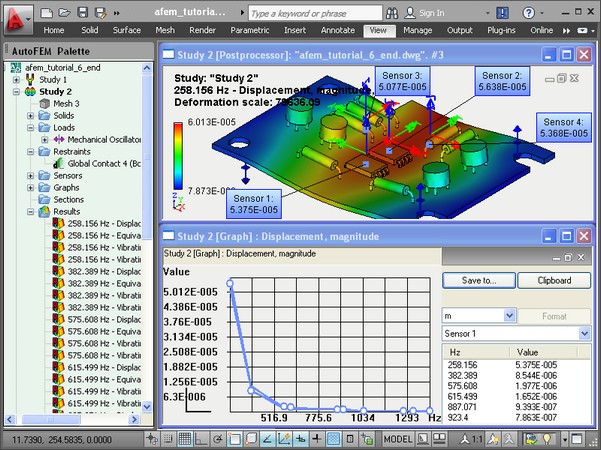 |
AutoFEM Analysis Analysing Results | ||||||
In tab [Results], one can see the following types of results divided into eight groups:

The group “Loads” includes the following results: components applied to the finite element model and the module of loads reduced to nodes. This type of results is for reference.
The group “Displacements” includes:
•Displacements of points of the finite element model with the account of the phase shift relative to the phase of exciter in the direction of axes of global coordinate system (CS): ![]()
 ,
, ![]()
 ,
, ![]()
 , as well as the displacement module
, as well as the displacement module ![]() .
.
•Actual part of displacements in the direction of axes of global CS: Re(UX), Re(UY), Re(UZ), as well as the module of the actual part of displacements ![]() .
.
•Virtual part of displacements in the direction of axes of global CS: Im(UX), Im(UY), Im(UZ), as well as the module of the virtual part of displacements ![]() .
.
•Amplitude of displacements of points of the finite element model (with no account of the phase shift relative to the exciter phase) in the direction of axes of global CS: UXm, UYm, UZm, as well as the amplitude module ![]()
 .
.
•Phase angles for displacement components of points of the finite element model in the direction of axes of global CS relative to the exciter phase ![]() ,
, ![]() ,
, ![]() , as well as the phase angle module
, as well as the phase angle module ![]() .
.
In the case if the phase shift is set, one can obtain separate diagrams for the actual and virtual components of displacements, as well as the absolute value of the phase in the points of the finite element model.

In the group “Vibration acceleration”, one may note the derivation of diagrams of amplitudes of vibration accelerations pertaining to the points of the finite element model U''m=Umω2  . The vibration acceleration phase differs by 180 (π rad) from the displacement phase.
. The vibration acceleration phase differs by 180 (π rad) from the displacement phase.
In the group “Vibration overloads”, one may note the derivation of diagrams of vibration overloads U''m/g, measured in respect of the free fall acceleration.
Also the graph of the result can be displayed.

See also: Forced Oscillation Analysis, Theory Background, Specific Pre-Processor Settings, Steps of Oscillation Analysis, Settings of Oscillation Solver